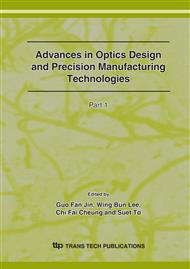p.1083
p.1089
p.1095
p.1100
p.1105
p.1111
p.1117
p.1123
p.1128
Scanning Photoacoustic Tomography of Biological Tissues with a Piezoelectricity Double-Ring Sensor
Abstract:
Scanning photoacoustic tomography with a piezoelectric double-ring sensor was explored to image biological tissues, and short laser pulses irradiated tissues to generate acoustic waves by thermoelastic expansion. The laser-induced photoacoustic waves were detected by a piezoelectric double-ring sensor. This double-ring sensor has the advantage that it is more sensitive in the forward direction compared with other conventional sensors. An optical fiber for illumination of the sample was integrated with the sensor, which enabled reflection-mode detection of ultrasonic waves. Consequently, two-dimension photoacoustic tomography of biological tissues could be obtained in a manner analogous to the ultrasound B-scan mode by a linear scan over the tissue surfaces. To reach a large depth, 1064nm laser light was used in our experiments. The experimental results showed that the reconstructed photoacoustic images agree well with the structures of the samples. It demonstrated that this sensor has potential to monitoring tumor angiogenesis, and antiangiogenic therapy in vivo.
Info:
Periodical:
Pages:
1105-1110
Citation:
Online since:
December 2007
Authors:
Keywords:
Price:
Сopyright:
© 2008 Trans Tech Publications Ltd. All Rights Reserved
Share:
Citation:


